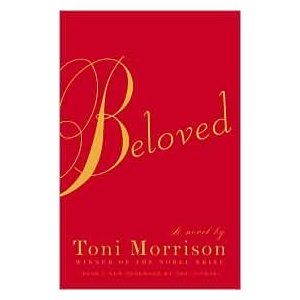“Beloved” by Toni Morrison

I first read Toni Morrison’s Beloved in 1996. I was in my second year of graduate school, and in a woman’s book group. I was new to the wish to become a better reader of better books. As part of claiming my books, I wrote in them. Alas, in Beloved, I wrote in red pen. While it’s interesting to see what moved me and felt important on my first read, it’s not what I want on my second read, sixteen years later. I am still mulling over getting a new copy. But for an upcoming discussion, because I couldn’t find an unmarked used copy (apparently, unsurprisingly, Beloved is the kind of book that gets marked up), I read my old copy.
I am certain that sixteen years, which included grad school in religion and umpteen books, helped make this a less bewildering read than it must have been back then. Also, knowing two key things about the book, since they will never be forgotten, made it “easier” to read than before. I put easier in quotes, because this is anything but an easy read. The blurbs are full of apt adjectives, like harrowing, stunning, dazzling, glorious, brilliant, shocking, brutal, magical, shattering. Both the history the novel relates–of the Middle Passage crossing and US slavery–as well as the emotions the richly drawn characters evoke, drew me in and forced me to read, think on, and feel things I’d really probably rather not. And yet, the reading of the book also makes it clear why it’s so important to know about these things, to not ignore them. The book bears witness to pain and ugliness, but also to beauty, strength, and hope.
Morrison’s writing is spare at the start, gets mystical in the middle with Faulknerian stream-of-consciousness chapters, and then more elaborate at the end.
124 was spiteful. Full of a baby’s venom. The women in the house knew it and so did the children. For years each put up with the spite in his own way, but by 1873 Sethe and her daughter Denver were its only victims.
Here’s what we know at the beginning. The house is haunted. Sethe is a former slave who lived with her mother-in-law, Baby Suggs, until the old woman died. One day a man named Paul D finds her. They once were slaves on a Kentucky plantation ironically named Sweet Home. Things proceed, moving back and forth, from there.
What struck me on this reading was that Beloved, with its ghost and grisly past, has all the hallmarks of a gothic horror story, which are blended with historical facts of the slave trade. I think it’s a toss up whether the gothic treatment highlights the horror inherent, or manages to make it able to be read, giving the reader just that small space of breathing room that fiction’s make believe can provide.
October 10th, 2012 at 8:40 pm
beloved was the first book that utterly confused me, yet i read it so it must have been assigned to me (highschool english? a university women’s lit course?) by the time i realize that the baby was haunting the house, i was too far in to start over. (plus i’d never re-started a book - books were easy companions that entertained me. they didn’t challenge me yet, or change me…)
there was a movie adaptation that i saw years later, and it made me take the book down from the shelf to reread the beginning… well, i kept on reading and by the time i looked up it was 3am, and i wasn’t tired in the least - i was THAT taken by it.